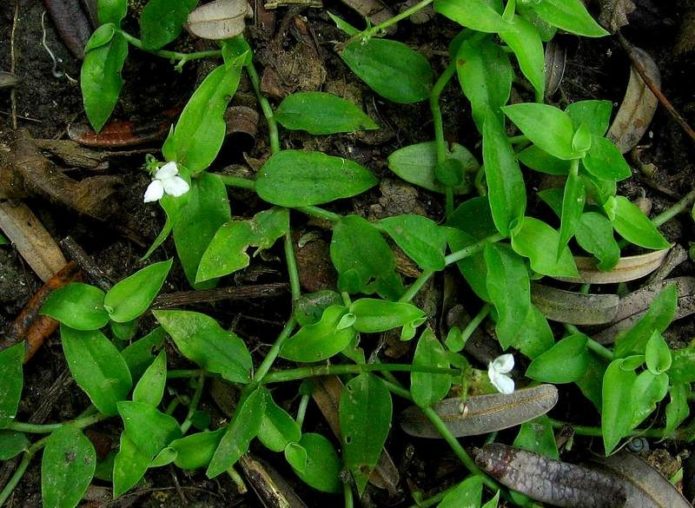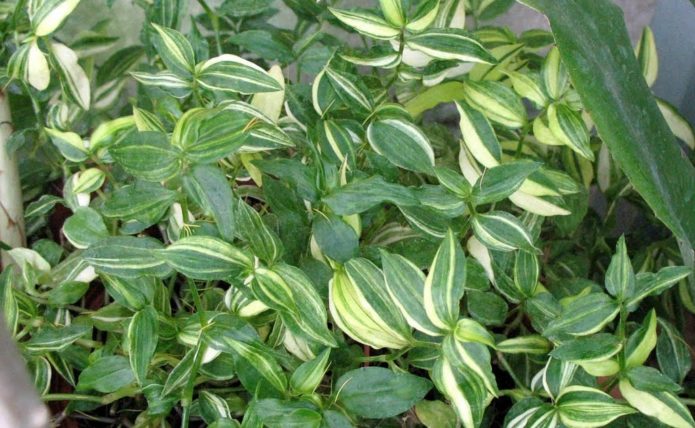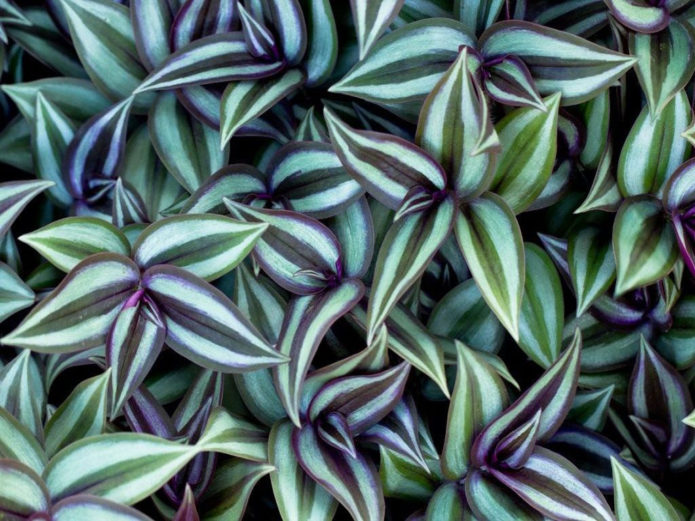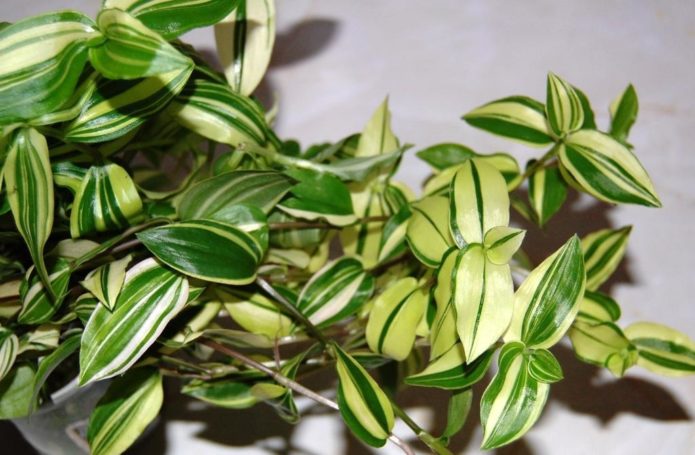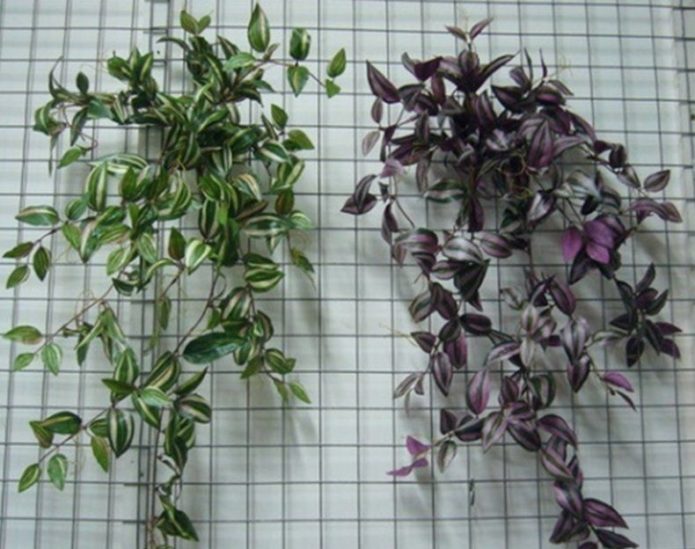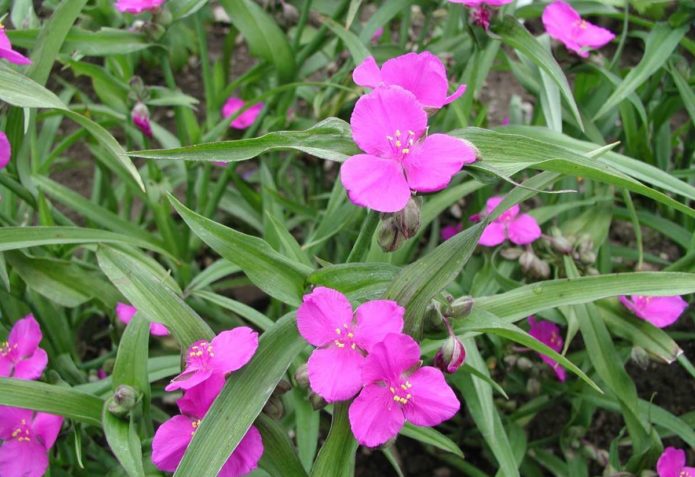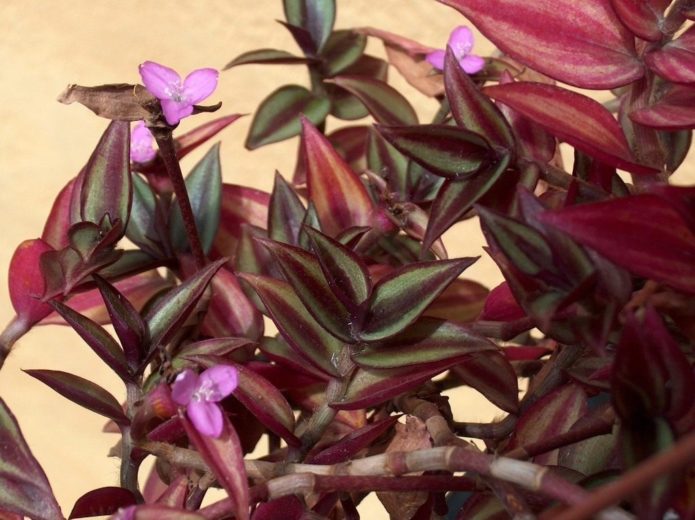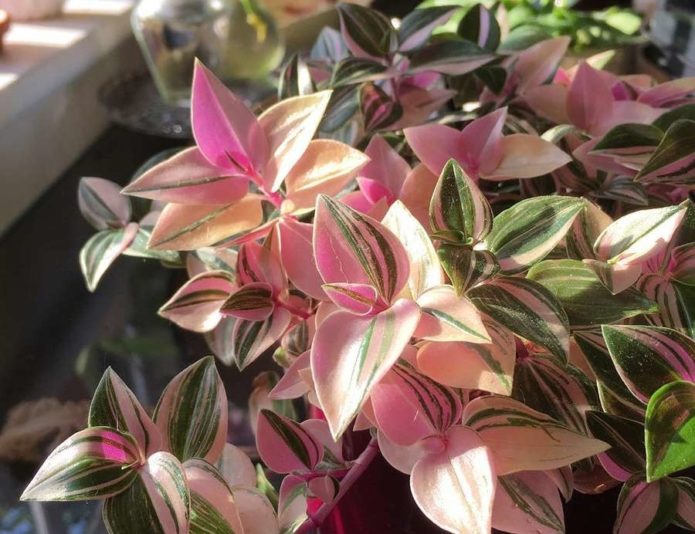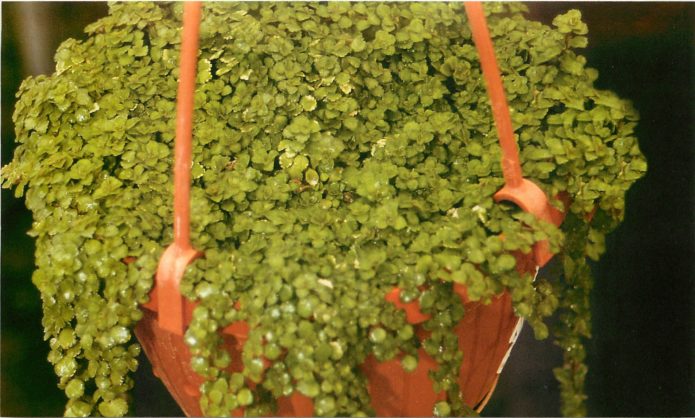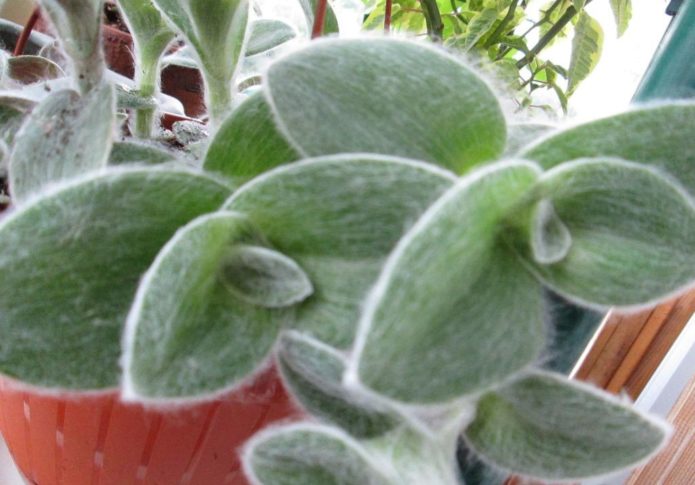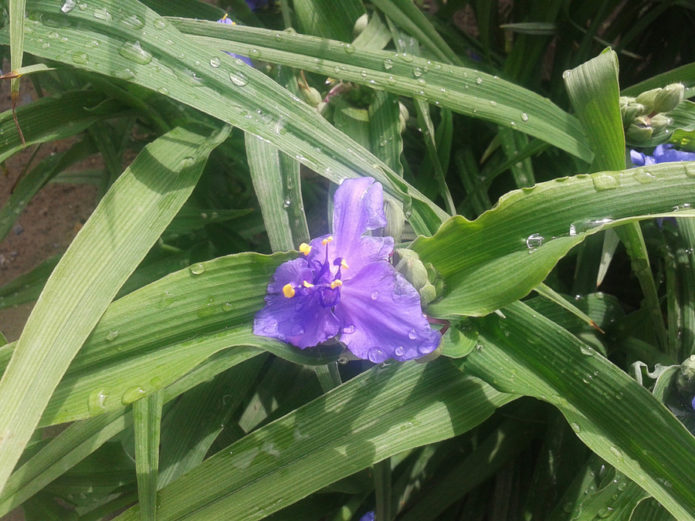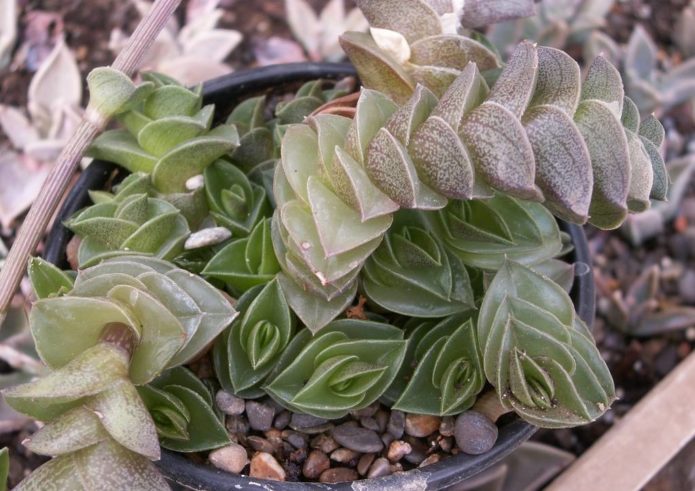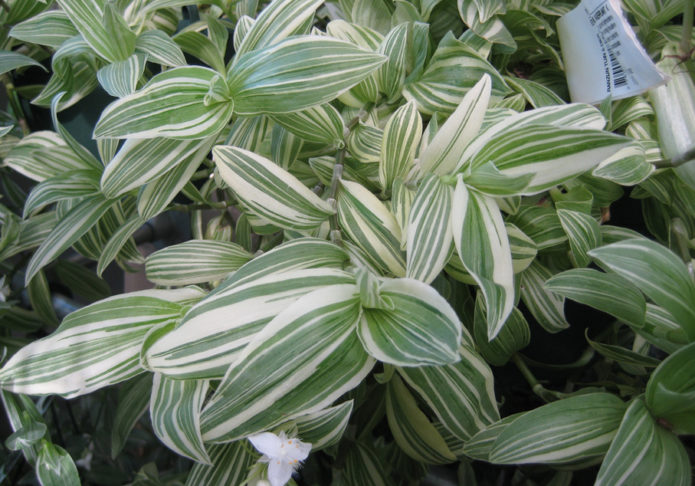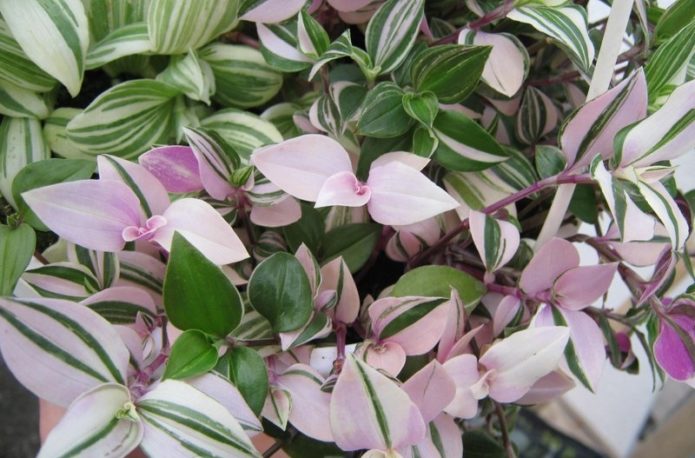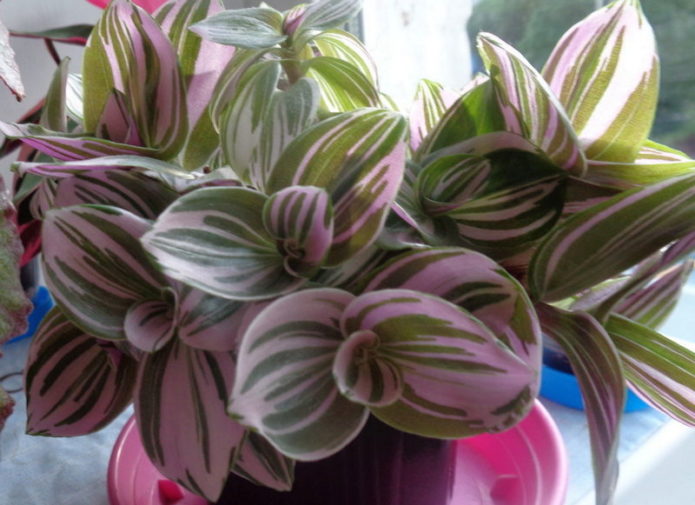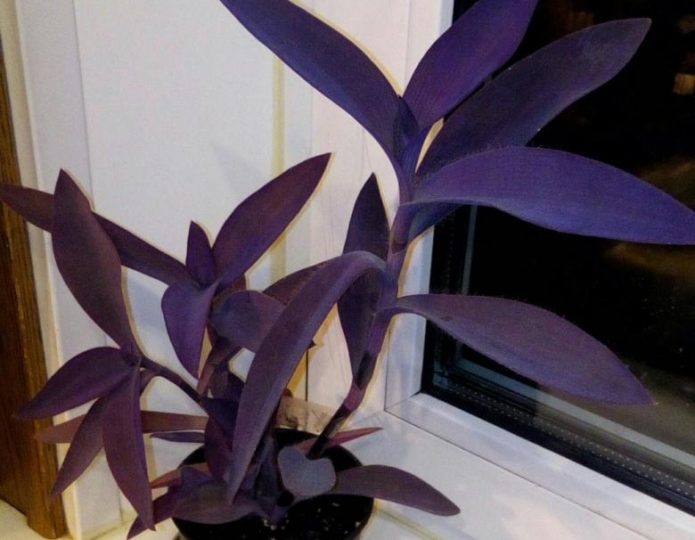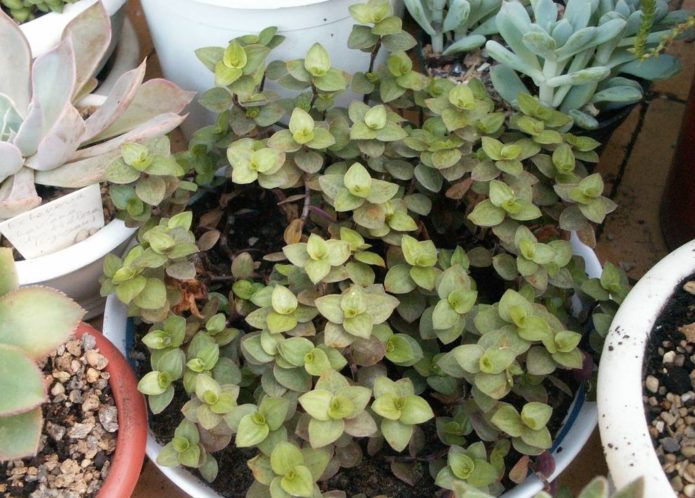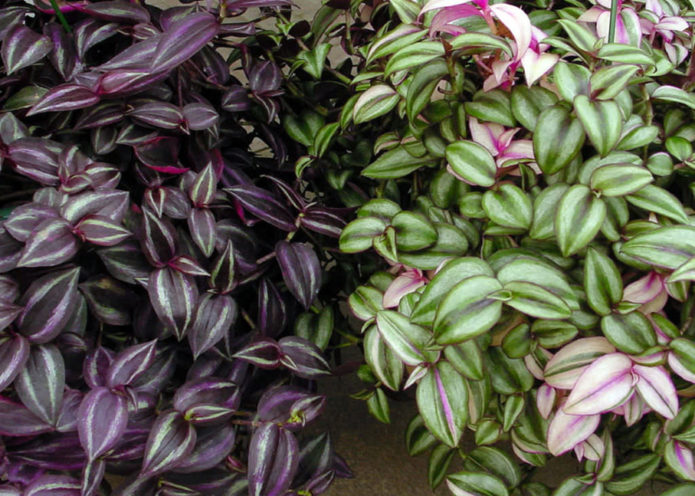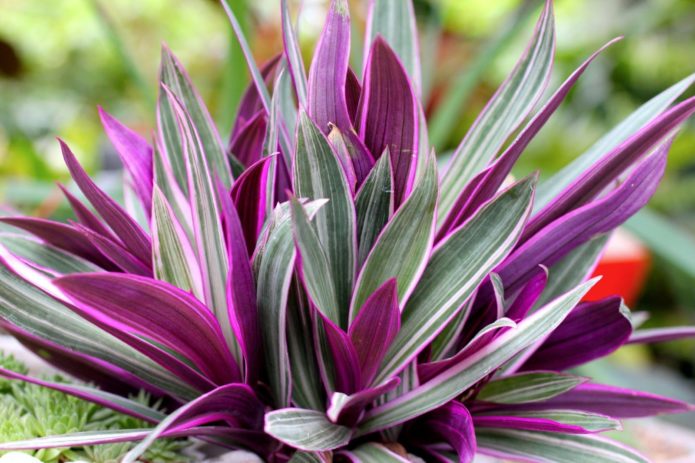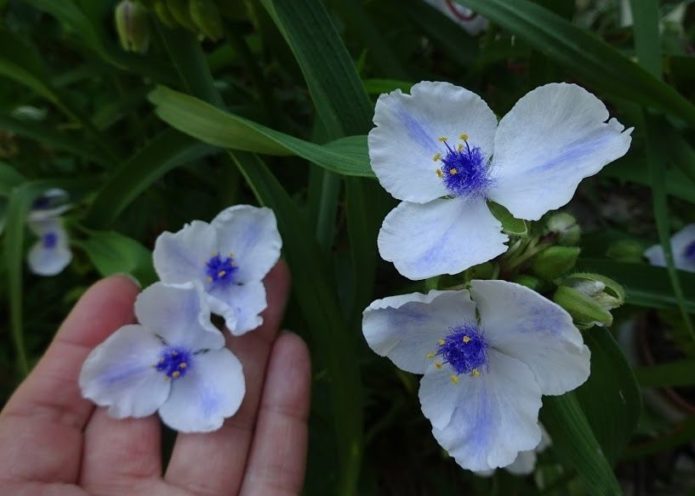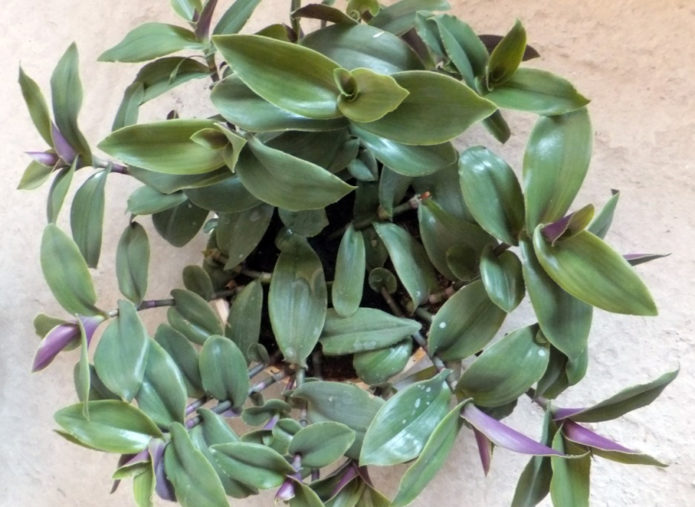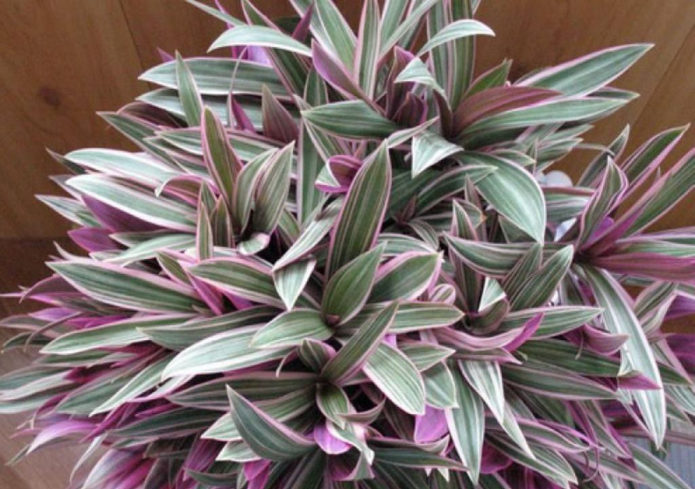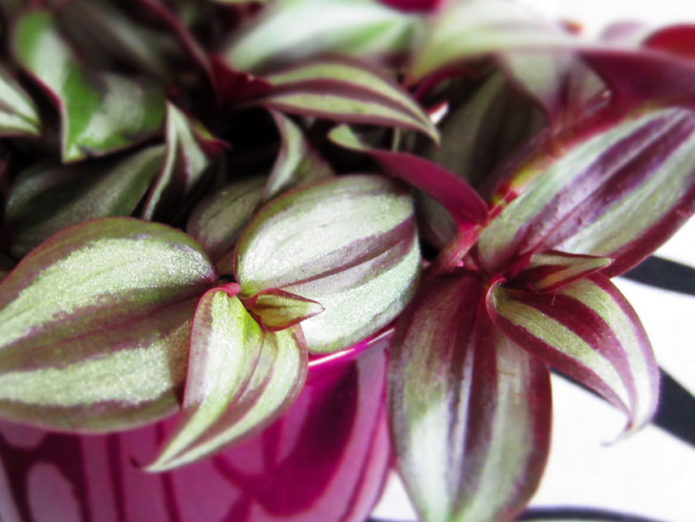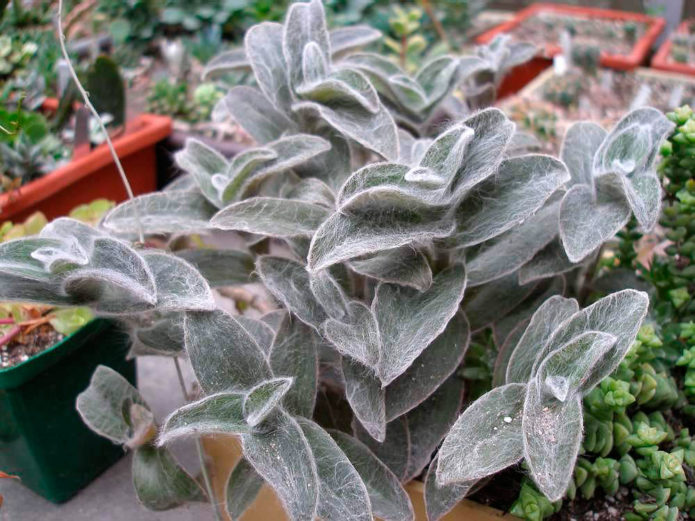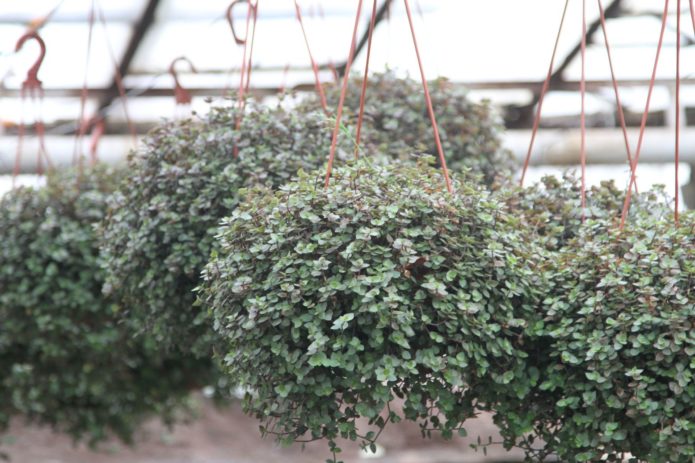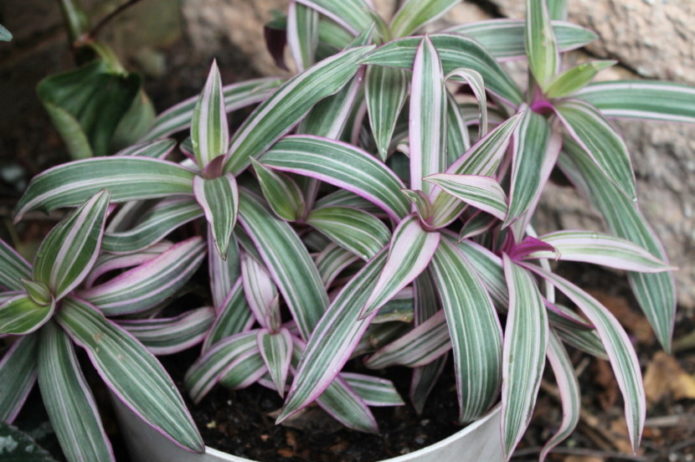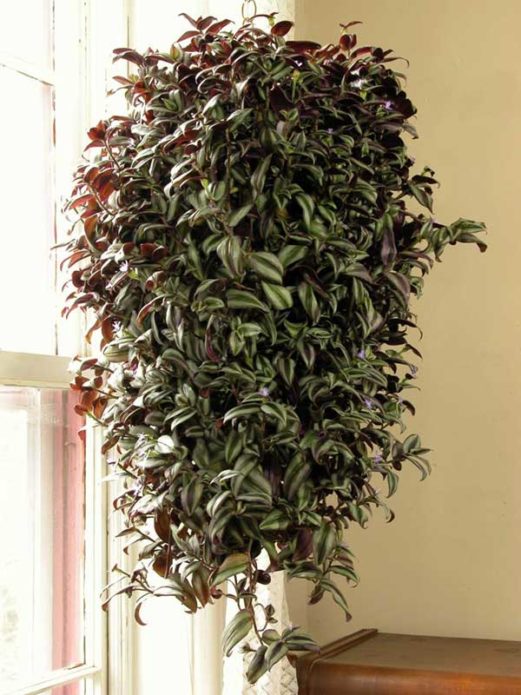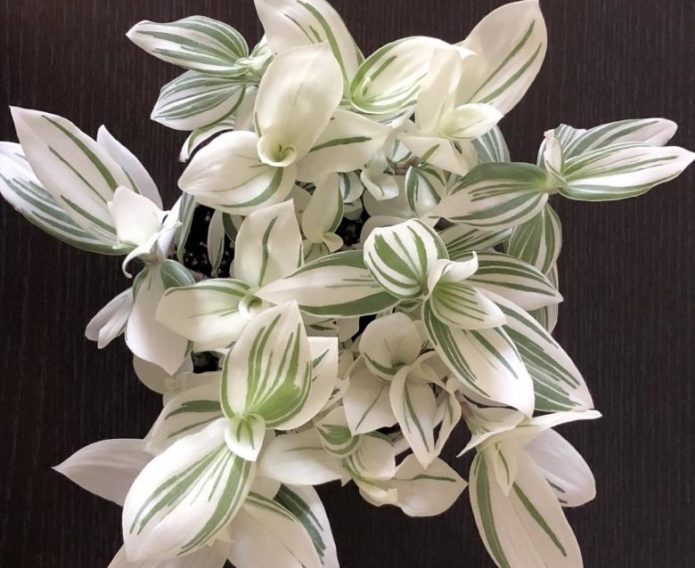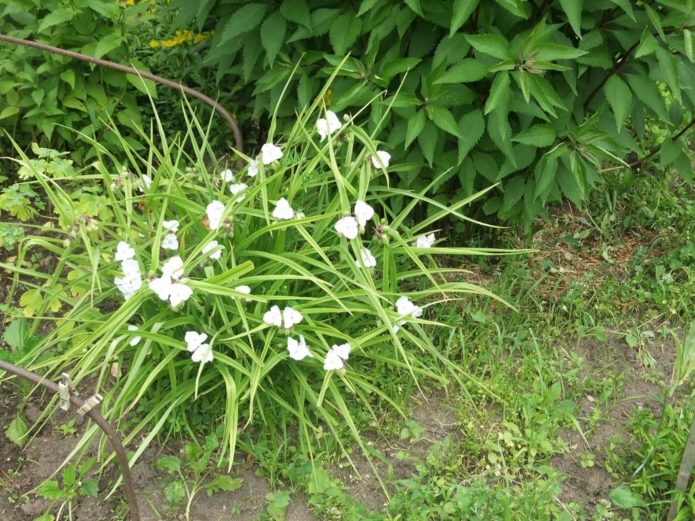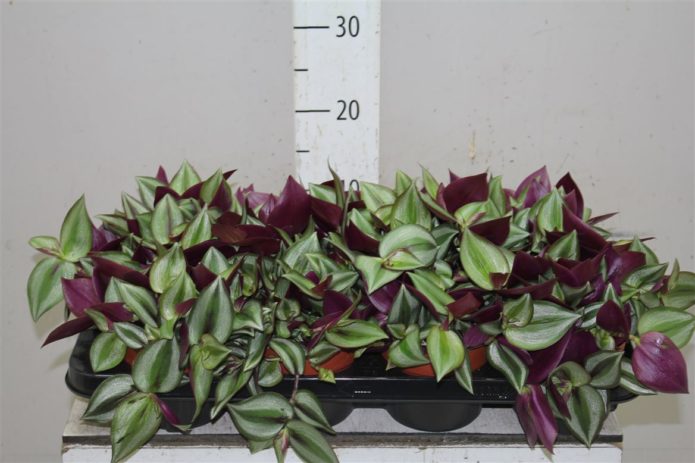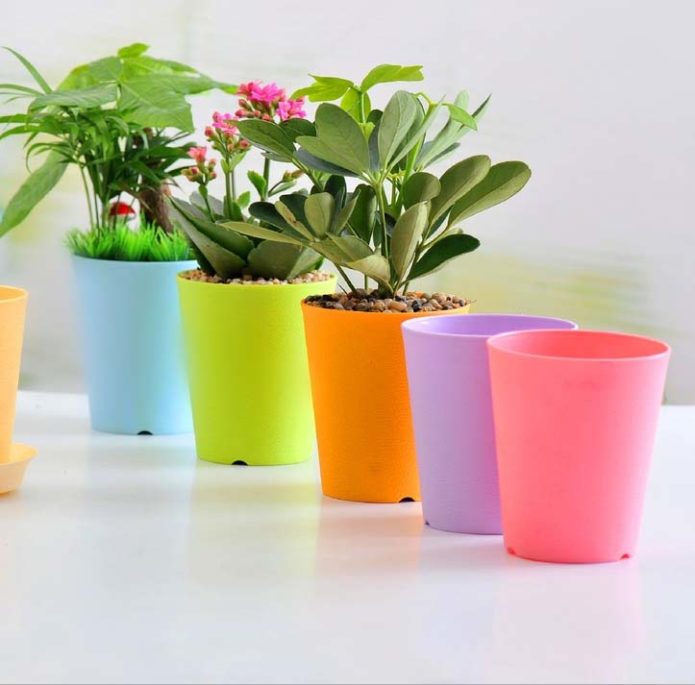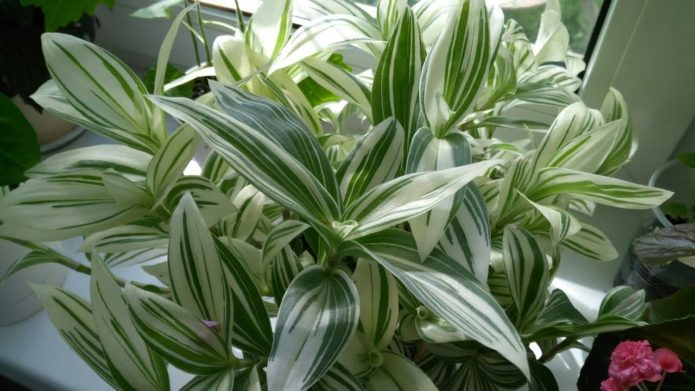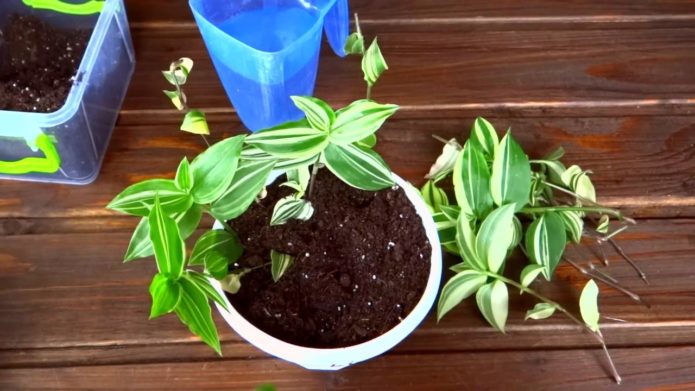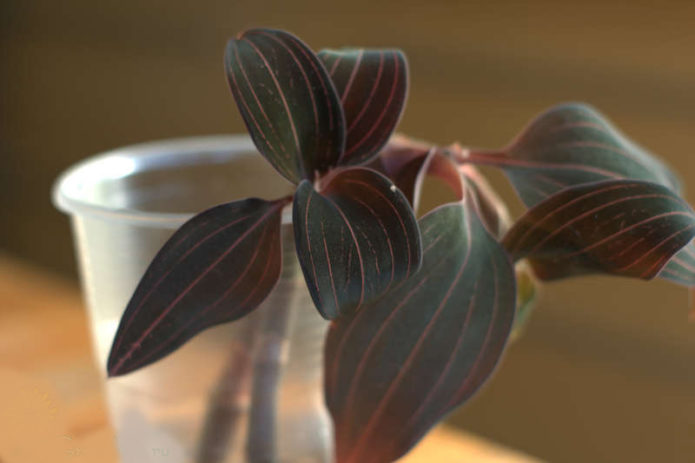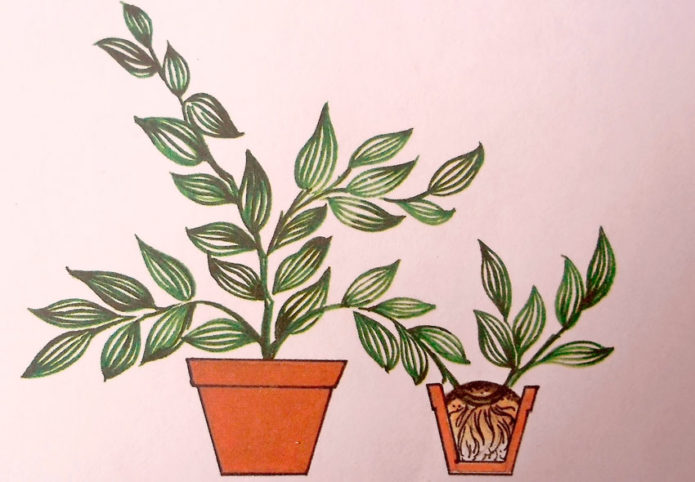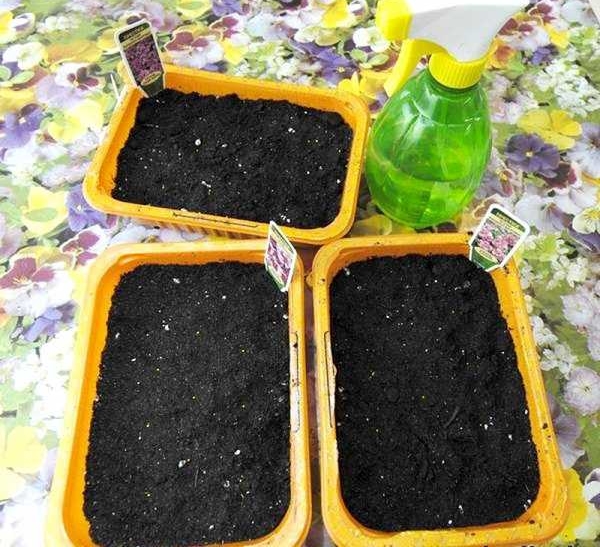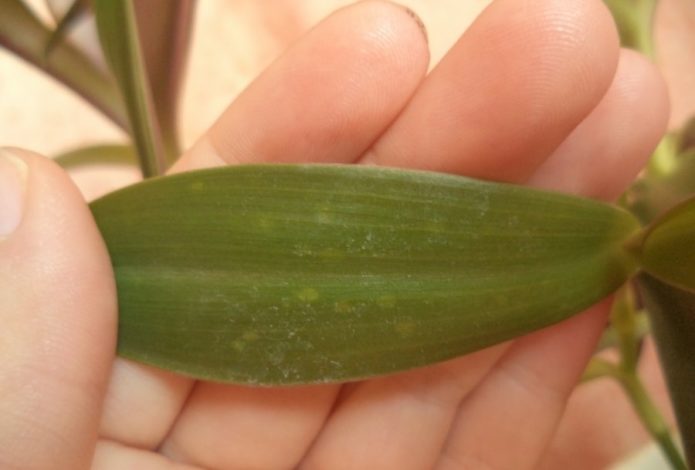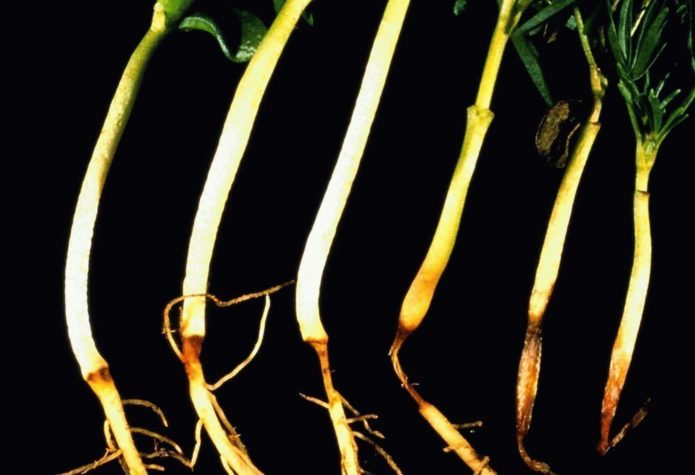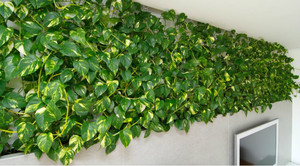Tradescantia is a perennial herb of the ampel type from the Hammelin family. It comes from America. In home and garden cultivation, this is one of the most common representatives, which is due to its unpretentious care and exotic appearance. Adhering to elementary tips, even an inexperienced florist can grow a lush flower from a single seed.
Content
What is interesting about Tradescantia and why is it so popular among flower growers
In the wild, Tradescantia grows mainly in North America in tropical forests, where it is considered a weed. Its shoots intensively fill the territory and quickly take root, thereby forming impassable thickets. Microscopic roots are found over the entire surface of the trunks. When in contact with a wet substrate, they instantly activate and begin to grow. It is successfully used in reproduction by flower growers.
In fact, the genus has more than 50 species, but not all of them have taken root at home. Due to the ability of the plant to stretch intensively in length, it is bred in hanging containers.... Stems in indoor varieties of Tradescantia can grow up to 1 meter, but garden ones are mostly miniature - no more than half a meter.
The deciduous component is especially attractive in Tradescantia, the color of which varies depending on the species. Leaves come in these shades:
- green;
- red;
- variegated;
- striped;
- purple;
- pink;
- multi-colored.
Surprisingly, the color saturation changes depending on the degree of exposure to light flux.
The surface of the leaves is dense, felt, smooth, terry. Tradescantia blooms with small flowers of various shades: white, lilac, purple and others. Flowering continues from spring to late autumn. The buds in a loose state last one or two days, then they fall off and fresh ones appear to replace them. The flower is characterized by continuous growth, since it does not have internal biorhythms.
Tradescantia is not poisonous, but care must be taken with some species. So, Tradescantia pale can irritate the skin. Therefore, after working with it, it is recommended to wash your hands with soap and water.
It would seem that an inconspicuous-looking flower became famous for many advantages:
- cleans the indoor air from harmful impurities, viruses and microbes;
- eliminates electromagnetic radiation from household appliances;
- used in folk medicine as a medicinal plant for external use (relieves edema, accelerates wound healing, stops bleeding);
- improves the microclimate;
- normalizes the energy background in the house: neutralizes negativity, removes the evil eye and spoilage, helps to improve relationships between household members.
Pets enjoy the juicy leaves of tradescantia with pleasure, as well as aquarium fish. In the first case, in order to avoid damage to the flower, it is better to put it higher or hang it in a flowerpot.
Types and varieties with photos
Of the whole variety of species and varieties of Tradescantia, the following are the most popular in home and greenhouse breeding.
In fact, Tradescantia is not subdivided into indoor and garden varieties. A flower growing in the house when transplanted into the garden for the summer period successfully takes root. Therefore, there will be no difficulties with the selection of the appropriate variety.
White-flowered
Blossfeld
Scaphoid
Zebrina, or hanging
Anderson
Purple (pale)
Riverside
Small-leaved
Sillamontana
Virginia
Veiled (reo)
Variegated (variegated)
Brashing Bride
Quadricolor
Striped
Setcreasia
Osprey
Callisia
Max Double
Red Grape
Bilberry Ice
Sitara
Tricolor
Red
Felt
Curly
Lodges
Ampelnaya
Pink
Green
White
Multicolored
Purple
Charm (mix)
Mini (miniature)
Growing conditions
Tradescantia, due to its tropical origin, develops more actively in warmth and in bright light. Prolonged exposure to direct sunlight can cause burns on the leaves. Light shading is allowed. Only it is not recommended to keep variegated varieties in the twilight constantly, which is why they lose their decorative effect. But with diffused bright light, the color becomes richer. The plant does not tolerate stale air in the room, so airing should be done regularly. Drafts are unacceptable.
Best of all, Tradescantia will feel at windows facing east, southeast or southwest. Flower pots are hung directly on window openings or next to them. You can also decorate the walls in bright rooms.
Comfortable conditions for growing Tradescantia:
- Constantly high humidity. For this, bowls with water or damp pebbles, mini-fountains are placed nearby, foliage is sprayed with settled water every day, especially in summer with steadily hot weather. In winter, it is enough to resort to this procedure every 7–8 days. Varieties with pubescent leaves do not need to be sprayed.
- The optimum temperature in the summer season is 22–26 ° C, in winter it is not lower than 10–12 ° C.
With a lack of light, the plant is recommended to be illuminated, for which a phytolamp is used.
The nuances of planting and transplanting
The plant brought from the store should acclimatize in a new place, so you should not immediately replant it. If the flower is bought in autumn or winter, then it is advisable to wait until spring.
A home pot must be 2–3 cm in volume than the previous one, and shallow, because the root system does not grow deeper.
Step-by-step transplant technology:
- First, remove the flower from the pot together with an earthen lump and immerse it in water so as not to damage the roots. After some time, it will soften and lag behind on its own.
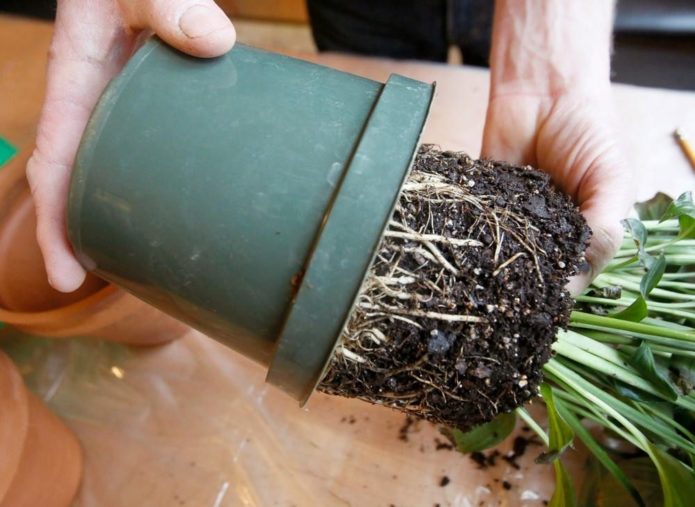
- Meanwhile, a new substrate is being prepared by mixing the following components: humus, turf, river sand, leaf compost. All parts are taken in equal proportions.
- A drainage layer of perlite, vermiculite or ceramic chips is poured into the bottom of the planting tank. Through holes are made in it at the same distance. You can plant several seedlings together.After installation in the holes, they are covered with soil, lightly tamped and watered.
The overgrown Tradescantia is transplanted in a similar way in early spring. Young plants are subjected to the procedure annually, adults as needed. If the roots begin to stick out from the ground, it means that they are cramped and it is time to change the capacity to a larger one.
Care features
Home care for tradescantia:
- Throughout the spring and summer, the plant is watered frequently and abundantly, but without creating stagnant water. Its remains are drained from the pallet half an hour after moistening. The frequency of watering is regulated independently, focusing on the degree of drying of the upper soil layer. In the autumn-winter period, the soil in the pot should be moderately moist. Irrigation water is pre-defended for a day at room conditions.
- In spring and summer, green varieties of Tradescantia are fed 2-3 times a month, alternating ready-made complex formulations with organic matter (peat, infused manure, grass compost). In autumn and winter, they do not do this, or they reduce the introduction of dressings to once a month and in a lower dosage. Variegated species are watered exclusively with mineral fertilizers.
- The plant is cut off several times a year. This allows you to achieve splendor.
Since the plant stretches quickly, many growers systematically pinch the tops. Others do not touch the shoots for a long period, and then cut off the upper part and plant them separately. Soon, new plants grow from the scraps. Old individuals are dug up and disposed of, since in the third year of growth they are completely naked and no longer represent aesthetic value.
Like most plants, Tradescantia does not stably enter the dormant stage with the onset of winter. This happens only when the temperature drops to 10 ° C and below. Therefore, in the winter, the plant usually exists as usual. And since the daylight hours are getting shorter, you will need to install fluorescent lamps for backlighting.
Only two garden species of Tradescantia have a clearly defined rest period: Virginia and Anderson. They can hibernate outside without any problems.
Reproduction: methods and instructions
There are several ways to propagate tradescantia:
- cuttings;
- division;
- layering;
- seeds.
The first two options are most common. The only problem is the risk of breaking the stems, as they are extremely fragile, so you should proceed with extreme caution.
Cuttings
Any time period is suitable for cuttings, however, in winter, rooting may not last much longer. Cuttings are recommended to be harvested from shoots that are more than a year old.
- Shoots are cut obliquely into slices up to 15 cm long.

- A mixture of humus, sand and leaf compost is poured into a shallow container in equal proportions. 8-10 cuttings are planted in one pot, so that the flower eventually grows more magnificently. Previously, all the sheets are removed from the bottom. The branches are deepened into the ground by 2–3 cm and poured abundantly with water at room temperature. Can be covered with a glass or plastic cap. After the appearance of fresh buds, it is removed.
- The planted young are placed in a warm, bright place.
Rooting occurs literally in 5-6 days... A month later, a small bush will form from the workpiece.
The cutting is no less successful in taking root in the water. Only all the time you need to replace the water with fresh water. Then the cuttings are transplanted into the ground.
By division
Florists often resort to reproduction of Tradescantia by division. It is convenient to do this during spring pruning. The roots of the plant are strong and can withstand any manipulations, so this method is the most productive.
Step-by-step instruction:
- They take a flower out of the pot along with an earthen lump, gently shake off the soil.
- Divide the roots into several parts using any sharp instrument.
- The resulting bushes are planted separately and shed well.
Rooting cuttings
Thanks to the creeping stems of Tradescantia, they can be rooted without cutting off from the mother bush. A smaller container filled with a substrate is installed next to an adult plant.A grooved depression is made in it and a shoot is placed in it. For a tighter fit, it is fixed with wire or a hairpin. You can sprinkle it with earth a little.
Until the cuttings take root, it must be moistened daily. After about a month, the shoot is cut off from the source, and it will already grow as an independent plant.
Seeds
Less common, but really feasible is considered to be seed culture. Sowing seeds is most successful in March.
- The planting material is first soaked in warm water for 2-3 hours. Any growth promoter can be added.
- For sowing, you need a sand-peat mixture. The seeds are pressed into the ground shallowly.
- The container is covered with glass to create a greenhouse effect. The optimum temperature for germination is 20–22 ° C.
- Every day, the protection is raised for ventilation and at the same time the soil is moistened with a spray bottle. As soon as 2–3 true leaves are formed, they start picking in individual pots.
Diseases and pests
Tradescantia rarely gets sick, but sometimes it is affected by pests: spider mites, aphids, scale insects... If appropriate measures are not taken in time, the plant will soon die.
Shield
Rusty spots appear on leaf blades and shoots, which leads to yellowing and death. On closer inspection, small bugs are visible.
The flower is washed with soapy water or alcohol, then the composition is washed off under running clean water. If necessary, the procedure is repeated after 5-7 days.
Aphid
In this case, young leaves and trunks wither, and a slimy plaque forms. On them you can see motionless green (gray) midges up to 5 mm in size.
The culture is treated with dandelion infusion: 40 g of roots and the same amount of leaves are poured with boiling water in an amount of 1 liter. After a two-hour exposure, the tradescantia is wiped off with the finished liquid. Do this every 9-10 days until the parasites are completely eliminated. Slime from the sheet plates is removed with soapy water.
Spider mite
Shoots in the presence of a pest are covered with a white thin web. The flower is washed with soapy water.
If folk remedies do not help in all these cases, then systemic insecticides are used: karbofos, actellik.
Diseases
The most common tradescantia disease is root rot.... This happens as a result of frequent and abundant watering. To avoid such an ailment, it is recommended to adjust the irrigation schedule and promptly drain the water accumulating in the pan. If the flower is already affected, then remove it from the soil and cut off the decaying parts of the roots. Then they are transplanted into a fresh substrate.
How care errors manifest
When no pests are found, and the plant is withering away every day, then the reason is improper care. Frequent mistakes in the care of Tradescantia and their consequences:
- Exposure of shoots, foliage falling - a lack of light, mineral fertilizing and moisture. Move the pot to a well-lit place, additionally add appropriate dressing and water it, without waiting for a crust to form on the surface.
- Loss of rich color in foliage - excessive being in the shade. Change the location of the flower pot.
- Withering and yellowing of leaves with the appearance of yellow spot - insufficient watering. Normalize the regime.
- Drying and darkening of the tips of the leaves - dry air in the room. Place a tray with water next to it or install a humidifier in the room.
When the primary sources that cause the plant's unhealthiness are eliminated, everything returns to normal.
The value of Tradescantia among flower growers, especially beginners, is explained by its simplicity in care. Even with irregular watering, the plant continues to grow successfully. But if you want to get a large-scale branched flower with an exquisitely falling cascade of stems, you will need to make a little effort.
